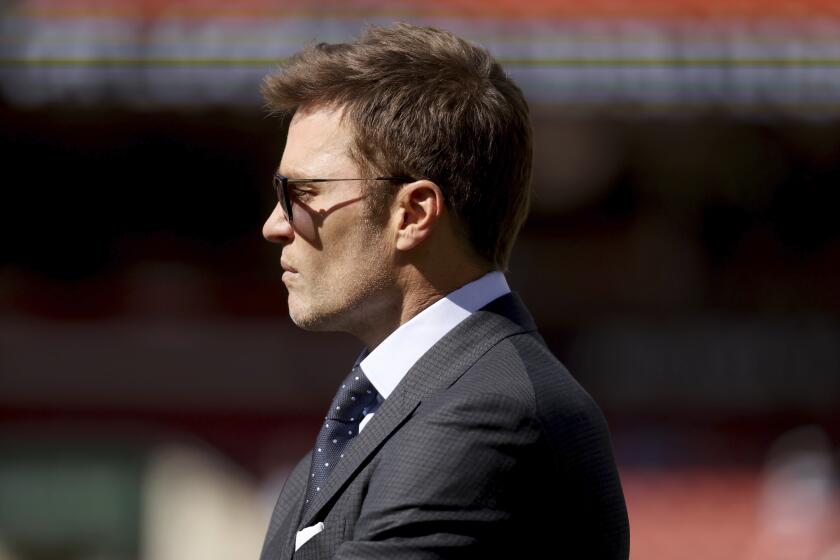For USC football players, track and field is back on the calendar
USC receiver Marqise Lee and running back D.J. Morgan are accustomed to catching passes. Trojans defensive backs Nickell Robey and Tony Burnett have been trained to knock them down.
On Saturday, the quartet will make passes — by handing off a baton — when they compete together in the 400-meter relay in the USC track team’s season-opening outdoor competition at the Claremont Relays.
It’s the first time since the early 2000s that USC football players have migrated en masse to the track, restoring a tradition that once helped the Trojans win multiple conference championships in the spring sport.
Burnett, Lee and Robey also will compete in the long jump.
“The idea is to keep them healthy,” said Ron Allice, USC’s director of track and field. “Don’t hurt anything and just let them have fun.”
With spring football practice set to begin March 6, the players could compete in two meets before focusing mainly on football. Their availability for the March 24 Trojan Invitational, featuring defending NCAA champion Texas A&M, is to be determined.
But Allice and the players hope the foursome can establish qualifying marks for the Pac-12 championships in May and also help the Trojans in the April 28 dual meet against UCLA.
“My main goal is football,” said Morgan, a sophomore. “But I want to give 100% out there [on the track] too. I don’t want to waste my time or others’ time.”
Before the mid-2000s, USC had a long, successful tradition of players doubling in football and track and field.
Heisman Trophy winner O.J. Simpson and former NFL receivers Earl McCullouch and Curtis Conway are among the football players who also competed as sprinters.
Olympic gold medalists Quincy Watts, Ken Carpenter and Fred Kelly were track athletes who also participated in football.
When Allice came to USC in 1995, his office was next to the football offices and he said there was an unencumbered flow of athletes between the programs. Former football coach John Robinson embraced players’ participation in track and Paul Hackett, his successor, allowed them to honor the commitment.
Running back Sultan McCullough and defensive backs Darrell Rideaux and Marcell Almond were among the football players who ran track.
When Pete Carroll arrived as football coach in 2001, however, migration from the football practice field to the track stadium across the street ebbed.
“Verbally, Pete said ‘no problem,’” Allice said, laughing, “But I never saw them anymore. I guess they’d get lost on their way over.”
Lane Kiffin, however, gave his blessing for the crossover, which requires coaches to apportion and document the total of 20 hours per week the NCAA allows for countable athletically related activities.
“It keeps them competitive,” said Kiffin, who replaced Carroll in 2010. “People worry about academics, but a lot of times our players do better academically during their season of competition because of the structure. Plus, it helps the university.”
It certainly helps Allice, who manages a men’s track program that has only 12.6 scholarships for athletes competing in 21 events.
“When we’ve been successful and won the [conference], it’s because we had football help,” he said.
The football players say they’re happy to provide it.
Burnett, a senior, came to USC as a long jumper. He made the football team as a walk-on in 2010 and earned a scholarship in 2011.
He encouraged Robey and Morgan to join him on the track.
“I’d been chirping at them, trying to get them to come last year,” he said.
But it was Lee, a freshman, who signed on first. The former three-sport standout at Gardena Serra High had talked of also playing basketball for the Trojans but opted for track instead.
“It’s fun trying to get that chemistry like we’ve got in football,” said Lee, who finished second in the long jump at the 2011 CIF state meet.
Robey, a sophomore who long-jumped 23 feet 9 inches in high school, came out the next day and found some unexpected, but welcome, challenges.
“The focus level is way different because you’ve got females out here,” he said, laughing. “Things are very smooth and chill.”
But also competitive.
Mike Pullins, in his 15th season as USC’s jumps coach, said the football players “moved the competitiveness meter way up” among all athletes in the program.
Nowhere is that more evident than among the relay teams.
On Thursday, as USC’s top 4x100 team warmed up, Morgan prodded them about the predicted outcome of Saturday’s event.
Terence Abram, a junior sprinter, took the good-natured ribbing in stride.
“They’re competitors and used to winning,” he said of the football players. “It’s good having them on the team. At the same time, we like winning too so it doesn’t take much to start, ‘Well, if you’re in our race, you’re not going to beat us.’
“It makes us all better.”
twitter.com/latimesklein
More to Read
Go beyond the scoreboard
Get the latest on L.A.'s teams in the daily Sports Report newsletter.
You may occasionally receive promotional content from the Los Angeles Times.











